Published Article by Mir M Khalid
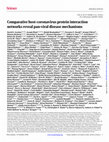
A cross-coronavirus study of protein function A central goal of this study is to understand, from... more A cross-coronavirus study of protein function A central goal of this study is to understand, from a systems level, the conservation of target proteins and cellular processes between SARS-CoV-2, SARS-CoV-1 and MERS-CoV, and thereby identify shared vulnerabilities that can be The COVID-19 (Coronavirus disease-2019) pandemic, caused by the SARS-CoV-2 coronavirus, is a significant threat to public health and the global economy. SARS-CoV-2 is closely related to the more lethal but less transmissible coronaviruses SARS-CoV-1 and MERS-CoV. Here, we have carried out comparative viral-human protein-protein interaction and viral protein localization analysis for all three viruses. Subsequent functional genetic screening identified host factors that functionally impinge on coronavirus proliferation, including Tom70, a mitochondrial chaperone protein that interacts with both SARS-CoV-1 and SARS-CoV-2 Orf9b, an interaction we structurally characterized using cryo-EM. Combining geneticallyvalidated host factors with both COVID-19 patient genetic data and medical billing records identified important molecular mechanisms and potential drug treatments that merit further molecular and clinical study.
A B S T R A C T The post-infectious autoimmune polyradiculoneuropathy Guillain-Barré syndrome (GB... more A B S T R A C T The post-infectious autoimmune polyradiculoneuropathy Guillain-Barré syndrome (GBS) is triggered by molecular mimicry between microbial glycolipid antigens and human peripheral nerve gangliosides. Single nucleotide polymorphisms in exon 2 of CD1A (*01/*02) and CD1E (*01/*02) were assessed using PCR-RFLP; no significant differences in genotype or allele frequency were observed between 200 patients with GBS and 200 healthy controls. CD1 gene polymorphisms cannot be recognized as a susceptibility or disease-causative factor for GBS in the Bangladeshi population. However, further studies are necessary to investigate the CD1A*01/ CD1E*01 haplotype distribution and its potential causative role in the axonal form of GBS.
Guillain-Barré syndrome (GBS) is a post-infectious autoimmune polyneuropathy regulated by pro- an... more Guillain-Barré syndrome (GBS) is a post-infectious autoimmune polyneuropathy regulated by pro- and anti-inflammatory cytokines; TNFA polymorphisms may exert immune pathogenic roles in GBS. We assessed TNFA promoter region polymorphisms (-238G/A, -308G/A, -857C/T, -863C/A) in Bangladeshi patients with GBS (n = 300) and healthy controls (n = 300) by PCR-RFLP and ASO-PCR. TNFA -863CA was significantly associated with GBS disease susceptibility (P = 0.0154) and disease severity (P = 0.0492). TNFA -238A allele was more frequent among anti-ganglioside (GM1) antibody-positive patients (P = 0.0092) and -863AA associated with AMAN subtype of GBS (P = 0.0398). TNFA -863C/A may contribute to GBS severity and pathogenesis in Bangladeshi patients.
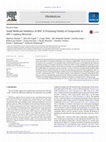
Persistence of latently infected cells in presence of Anti-Retroviral Therapy presents the main o... more Persistence of latently infected cells in presence of Anti-Retroviral Therapy presents the main obstacle to HIV-1 eradication. Much effort is thus placed on identification of compounds capable of HIV-1 latency reversal in order to render infected cells susceptible to viral cytopathic effects and immune clearance. We identified the BAF chromatin remodeling complex as a key player required for maintenance of HIV-1 latency, highlighting its potential as a molecular target for inhibition in latency reversal. Here, we screened a recently identified panel of small molecule inhibitors of BAF (BAFi's) for potential to activate latent HIV-1. Latency reversal was strongly induced by BAFi's Caffeic Acid Phenethyl Ester and Pyrimethamine, two molecules previously characterized for clinical application. BAFi's reversed HIV-1 latency in cell line based latency models, in two ex vivo infected primary cell models of latency, as well as in HIV-1 infected patient's CD4+ T cells, without inducing T cell proliferation or activation. BAFi-induced HIV-1 latency reversal was synergistically enhanced upon PKC pathway activation and HDAC-inhibition. Therefore BAFi's constitute a promising family of molecules for inclusion in therapeutic combinatorial HIV-1 latency reversal.
Conference paper by Mir M Khalid
Conference Presentations by Mir M Khalid
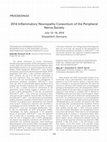
Complement activation plays a crucial role in the pathogenesis
of Guillain-Barré syndrome (GBS), ... more Complement activation plays a crucial role in the pathogenesis
of Guillain-Barré syndrome (GBS), especially in
pathogen recognition and nerve damage. Previous studies
indicated that severity in GBS is associated with genetic
polymorphisms of mannose binding lectin (MBL). This pattern
recognition receptor of the innate immune system binds
to repetitive sugar moieties on both pathogens and apoptotic
cells leading to complement activation via the lectin
pathway and subsequent killing or clearance. We aimed to
confirm if MBL2 genotypes and MBL levels are associated
with the GBS susceptibility and severity in patients from Bangladesh and conducted a meta-analysis. Polymorphisms
in the promoter region and exon 1 of the MBL2 gene was
determined in 322 GBS patients and 320 healthy controls
using high throughput melt curve genotyping by real time
PCR. GBS patients had significant higher frequency of the
HH genotype, HY haplotype, and HYA haplotype compared
to healthy controls (p<0.004). Two H-alleles or two HYA
haplotypes compared to a single H-allele or HYA haplotype
further increased the risk of developing GBS. H-alleles and
HYA haplotypes were associated with more severe GBS
(MRC-sumscore <40) (p<0.05). HY genotypes were also
found associated with increased risk of developing GBS
(p<0.002). The frequency of the H-allele, the HY promoter
haplotype and the HYA haplotype were all associated with
an increased MBL production. Serum levels of MBL were
higher in severely affected patients compared to mildly
affected patients (P<0.001). Presence of anti-GM1 antibody
was also associated with high serum concentration of MBL
(p<0.05). MBL2 gene polymorphisms were not associated
with the presence of axonal or demyelinating subtypes of
GBS. Meta-analysis of the combined Dutch and Bangladeshi
dataset including 591 GBS patients and 530 healthy controls
revealed that HYA-allele and H-allele were associated with
the occurrence and severity of GBS. HYA-allele and H-allele
was associated with high level of MBL production in both
studies. In conclusion, MBL2 gene polymorphisms related to
high levels of serum MBL are associated with disease susceptibility and severity in GBS.
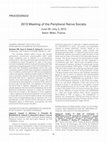
Guillain-Barr ´e syndrome (GBS) is a post-infectious
immune-mediated polyneuropathy. Complement a... more Guillain-Barr ´e syndrome (GBS) is a post-infectious
immune-mediated polyneuropathy. Complement activation
plays a crucial role in the induction and extent of the postinfectious
immune-mediated peripheral nerve damage in
GBS patients. Mannose-binding lectin (MBL) activates the
complement system via the lectin pathway after recognition
of repetitive sugar moiety on pathogens. We aimed to
investigate whether MBL2 genotype and serum MBL level
are associated with the development and severity of GBS
in Bangladeshi population. In this study, we determined
the polymorphisms in the promoter region and exon1 of
the MBL2 gene in 322 GBS patients and 320 healthy
controls using high throughput melt curve genotyping by
real time PCR. GBS patients had significant higher frequency
of the HH genotype, HY haplotype, and HYA haplotype
compared with healthy controls (p<0.004). Two H-alleles or
HYA genotype also increased risk of developing GBS two
to three times higher than one H-allele or HYA genotypes,
respectively. The frequencies of HH and HYA genotypes
were significantly associated with disease severity (p<0.05).
HY genotypes were also found associated with increased risk
of developing GBS (p<0.002). No significant distribution was
observed in exon1 polymorphism between GBS patients and controls. However, A/A haplotype in exon1 was
significantly associated with functional disability (F-score) at
entry (p<0.05). High serum concentration of MBL was found
among severely affected (MRC-sumscore <40) GBS patients
compared to mildly affected patients (MRC-sumscore ≥40).
Presence of anti-GM1 antibody was significantly associated
with high serum concentration of MBL in GBS patients
(p<0.05). No significant association was found in different
subtypes of GBS regarding MBL gene polymorphisms. In
conclusion, our study suggests an association between
MBL2 gene polymorphisms and severity of GBS in
Bangladesh. MBL2 gene polymorphisms related to high
production of MBL may induce more nerve damage and
clinical deficits in GBS patients

Guillain-Barré syndrome (GBS) is an acute inflammatory
demyelinating polyneuropathy, usually a po... more Guillain-Barré syndrome (GBS) is an acute inflammatory
demyelinating polyneuropathy, usually a post-infectious
autoimmune-mediated disorder of the peripheral nervous
system. Tumor necrosis factor-α (TNF-α) is one of the major
pro-inflammatory cytokines that may affect pathogenesis of
GBS. A definite role of TNF-polymorphism in the
pathogenesis of GBS is largely unknown; very few data are
available from developing countries. We aimed to investigate
polymorphisms in the promoter region of TNF-α gene in GBS
patients and healthy controls to assess their association for
GBS pathogenesis and disease outcome. In this study, we
performed a prospective study among 300 GBS patients,
enrolled from Dhaka Medical College Hospital and 300
healthy controls. TNF-α (-238G/A, -308G/A, -857C/T, and -
863C/A) polymorphisms were detected by polymerase chain
reaction-restriction fragment length polymorphism (PCRRFLP)
and allele specific-PCR. TNF-α -863C/A polymorphism
was significantly associated with GBS patients compared with
healthy controls. CA heterozygote of TNF-α -863 increased
the susceptibility of GBS patients compared with controls (P
<0.05, OR=1.5, 95% CI=1.1-2.2). TNF-α -863 AA mutant
genotype was significantly associated with LOS positive
patients compared with LOS negative patients (P<0.05,
OR=15.2, 95% CI=0.9-263.7). In addition, A allele of TNF-α
-863 was significantly associated with disease severity
(P<0.05, OR=1.8, 95% CI=1.1-2.8). However, TNF-α -238
G/A, -308 G/A and -857 C/T were not associated with GBS
pathogenesis and disease outcome. In conclusion, TNF-α -
863 A allele might play an important role for the severity and
pathogenesis of GBS in the Bangladeshi population, however,
further studies are required to confirm this study from
developed and low-income countries.
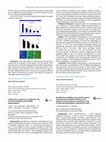
Background: Bangladesh has achieved a remarkable success to eradicate poliomyelitis, however, Gui... more Background: Bangladesh has achieved a remarkable success to eradicate poliomyelitis, however, Guillain–Barré syndrome (GBS)is frequently diagnosed. GBS is an autoimmune mediated disease of the peripheral nervous system preceded by infections. Campylobacter jejuni has been identified as the predominant cause of antecedent infection in GBS. C. jejuni lipopolysaccharide (LPS) induces antibodies cross-reactive with gangliosides and has shown to be involved in peripheral nerve damage. Toll-like receptor 4 (TLR4) is an important pathogen recognition receptor that recognizes mainly lipopolysaccharide (LPS) of gram-negative bacteria. In this study, we investigated functional single nucleotide polymorphisms (SNPs) in the extracellular domain of TLR4 (Asp299Gly and Thr399Ile), and assessed their association for GBS susceptibility, disease pathogenesis and disease outcome.
Methods & Materials: A hospital based case controlled study was conducted in Dhaka Medical College Hospital (DMCH) in Dhaka, Bangladesh in between 2010 to 2013. A total of 210 genomic DNA (105 consecutive patients with GBS and 105 healthy controls of Bangladeshi population) were isolated using QIAGEN (DNA) blood midi kit and genotyped by using polymerase chain reaction restriction fragment length polymorphism (PCR-RFLP).
Results: TLR4 (Asp299Gly) polymorphism were significantly associated with GBS patients compared with healthy controls (p < 0.05). Gly299Gly homozygote increased the susceptibility of GBS patients compared with healthy controls (p = 0.0365, OR= 8.9, 95% CI = 1.1-73.2). Acute motor axonal neuropathy (AMAN) was significantly associated with Gly299Gly homozygote (p=0.0093, OR=14.6, 95% CI = 1.6-130.7). TLR4 variant genotype Asp/Gly (p = 0.0441, OR= 2.6, 95% CI = 1.1-6.5) was associated with poor outcome (unable to walk after 6 months); suggesting that these genotype might be one of the factors contributing to a severe form of GBS. No significant association of TLR4 polymorphism (Asp299Gly and Thr399Ile) with anti-ganglioside antibodies was found. In addition, TLR4 Thr399Ile polymorphism had no role in GBS susceptibility as compared with controls.
Conclusion: TLR4 Gly299Gly homozygote is associated with the increased disease susceptibility to GBS. Gly299Gly homozygote is also associated with the axonal variant of GBS. However, TLR4 Asp299Gly polymorphism is prevalently significant with the disease outcome of GBS. Therefore, further study is required to confirm this association using a large cohort.
Papers by Mir M Khalid
Stem cell reports, Mar 1, 2023

Journal of Virus Eradication, 2016
distribution and reproduction in any medium or format, as long as you give appropriate credit to ... more distribution and reproduction in any medium or format, as long as you give appropriate credit to the original author(s) and the source, provide a link to the Creative Commons license and indicate if changes were made. The images or other third party material in this book are included in the book's Creative Commons license, unless indicated otherwise in a credit line to the material. If material is not included in the book's Creative Commons license and your intended use is not permitted by statutory regulation or exceeds the permitted use, you will need to obtain permission directly from the copyright holder. The use of general descriptive names, registered names, trademarks, service marks, etc. in this publication does not imply, even in the absence of a specific statement, that such names are exempt from the relevant protective laws and regulations and therefore free for general use.
Journal of Biological Chemistry

ABSTRACTAlthough the SARS-CoV-2 Omicron variant (BA.1) spread rapidly across the world and effect... more ABSTRACTAlthough the SARS-CoV-2 Omicron variant (BA.1) spread rapidly across the world and effectively evaded immune responses, its viral fitness in cell and animal models was reduced. The precise nature of this attenuation remains unknown as generating replication-competent viral genomes is challenging because of the length of the viral genome (30kb). Here, we designed a plasmid-based viral genome assembly and rescuestrategy (pGLUE) that constructs complete infectious viruses or noninfectious subgenomic replicons in a single ligation reaction with >80% efficiency. Fully sequenced replicons and infectious viral stocks can be generated in 1 and 3 weeks, respectively. By testing a series of naturally occurring viruses as well as Delta-Omicron chimeric replicons, we show that Omicron nonstructural protein 6 harbors critical attenuating mutations, which dampen viral RNA replication and reduce lipid droplet consumption. Thus, pGLUE overcomes remaining barriers to broadly study SARS-Co...
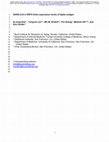
SummarySurvival from COVID-19 depends on the ability of the host to effectively neutralize virion... more SummarySurvival from COVID-19 depends on the ability of the host to effectively neutralize virions and infected cells, a process largely driven by antibody-mediated immunity. However, with the newly emerging variants that evade Spike-targeting antibodies, re-infections and breakthrough infections are increasingly common. A full characterization of SARS-CoV-2 mechanisms counteracting antibody-mediated immunity is needed. Here, we report that ORF8 is a SARS-CoV-2 factor that controls cellular Spike antigen levels. ORF8 limits the availability of mature Spike by inhibiting host protein synthesis and retaining Spike at the endoplasmic reticulum, reducing cell-surface Spike levels and recognition by anti-SARS-CoV-2 antibodies. With limited Spike availability, ORF8 restricts Spike incorporation during viral assembly, reducing Spike levels in virions. Cell entry of these virions leaves fewer Spike molecules at the cell surface, limiting antibody recognition of infected cells. Our studies p...
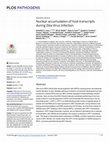
PLOS Pathogens
Zika virus (ZIKV) infects fetal neural progenitor cells (NPCs) causing severe neurodevelopmental ... more Zika virus (ZIKV) infects fetal neural progenitor cells (NPCs) causing severe neurodevelopmental disorders in utero. Multiple pathways involved in normal brain development are dysfunctional in infected NPCs but how ZIKV centrally reprograms these pathways remains unknown. Here we show that ZIKV infection disrupts subcellular partitioning of host transcripts critical for neurodevelopment in NPCs and functionally link this process to the up-frameshift protein 1 (UPF1). UPF1 is an RNA-binding protein known to regulate decay of cellular and viral RNAs and is less expressed in ZIKV-infected cells. Using infrared crosslinking immunoprecipitation and RNA sequencing (irCLIP-Seq), we show that a subset of mRNAs loses UPF1 binding in ZIKV-infected NPCs, consistent with UPF1’s diminished expression. UPF1 target transcripts, however, are not altered in abundance but in subcellular localization, with mRNAs accumulating in the nucleus of infected or UPF1 knockdown cells. This leads to diminished ...
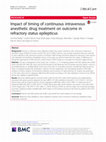
Background: Patients in refractory status epilepticus (RSE) may require treatment with continuous... more Background: Patients in refractory status epilepticus (RSE) may require treatment with continuous intravenous anesthetic drugs (cIVADs) for seizure control. The use of cIVADs, however, was recently associated with poor outcome in status epilepticus (SE), raising the question of whether cIVAD therapy should be delayed for attempts to halt seizures with repeated non-anesthetic antiepileptic drugs. In this study, we aimed to determine the impact of differences in therapeutic approaches on RSE outcome using timing of cIVAD therapy as a surrogate for treatment aggressiveness. Methods: This was a retrospective cohort study over 14 years (n = 77) comparing patients with RSE treated with cIVADs within and after 48 h after RSE onset, and functional status at last follow-up was the primary outcome (good = return to premorbid baseline or modified Rankin Scale score of less than 3). Secondary outcomes included discharge functional status, in-hospital mortality, RSE termination, induction of burst suppression, use of thiopental, duration of RSE after initiation of cIVADs, duration of mechanical ventilation, and occurrence of super-refractory SE. Analysis was performed on the total cohort and on subgroups defined by RSE severity according to the Status Epilepticus Severity Score (STESS) and by the variables contained therein. Results: Fifty-three (68.8%) patients received cIVADs within the first 48 h. Early cIVAD treatment was independently associated with good outcome (adjusted risk ratio [aRR] 3.175, 95% confidence interval [CI] 1.273-7.918; P = 0.013) as well as lower chance of both induction of burst suppression (aRR 0.661, 95% CI 0.507-0.861; P = 0.002) and use of thiopental (aRR 0.446, 95% CI 0.205-0.874; P = 0.043). RSE duration after cIVAD initiation was shorter in the early cIVAD cohort (hazard ratio 1.796, 95% CI 1.047-3.081; P = 0.033). Timing of cIVAD use did not impact the remaining secondary outcomes. Subgroup analysis revealed early cIVAD impact on the primary outcome to be driven by patients with STESS of less than 3. Conclusions: Patients with RSE treated with cIVADs may benefit from early initiation of such therapy.
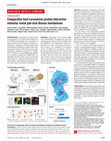
Science, 2020
How lethal coronaviruses engage hosts Severe acute respiratory syndrome coronavirus 2 (SARS-CoV-2... more How lethal coronaviruses engage hosts Severe acute respiratory syndrome coronavirus 2 (SARS-CoV-2) is closely related to the deadly coronaviruses SARS-CoV-1 and Middle East respiratory syndrome coronavirus (MERS-CoV). Considerable efforts are focused on developing treatments, and therapies that work across coronaviruses would be particularly valuable. Shedding light on the host factors hijacked by the viruses, Gordon et al. mapped the interactions between viral and human proteins for SARS-CoV-2, SARS-CoV-1, and MERS-CoV; analyzed the localization of viral proteins in human cells; and used genetic screening to identify host factors that either enhance or inhibit viral infection. For a subset of the interactions essential for the virus life cycle, the authors determined the cryo–electron microscopy structures and mined patient data to understand how targeting host factors may be relevant to clinical outcomes. Science , this issue p. eabe9403
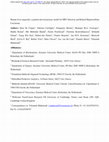
The molecular events that drive Hepatitis B virus (HBV)-mediated transformation and tumorigenesis... more The molecular events that drive Hepatitis B virus (HBV)-mediated transformation and tumorigenesis have remained largely unclear, due to the absence of a relevant primary model system. Here we interrogate the potential of human liver organoids as a platform for modeling HBV infection and related tumorigenesis. We show that organoids derived from HBV-infected patients display an aberrant early cancer gene signature, which clusters with the HCC cohort on the TCGA LIHC dataset and away from healthy liver tissue. Furthermore, we demonstrate HBV infection in healthy donor liver organoids after challenge with recombinant virus or HBV infected patient serum. Ex vivo infected liver organoids produced cccDNA, expressed intracellular HBV RNA and proteins, and produced infectious HBV. HBV replication supported by ex vivo infected liver organoids was blocked by treatment with Tenofovir, highlighting the potential of this model system as a primary differentiated hepatocyte platform for HBV drug s...










Uploads
Published Article by Mir M Khalid
Conference paper by Mir M Khalid
Conference Presentations by Mir M Khalid
of Guillain-Barré syndrome (GBS), especially in
pathogen recognition and nerve damage. Previous studies
indicated that severity in GBS is associated with genetic
polymorphisms of mannose binding lectin (MBL). This pattern
recognition receptor of the innate immune system binds
to repetitive sugar moieties on both pathogens and apoptotic
cells leading to complement activation via the lectin
pathway and subsequent killing or clearance. We aimed to
confirm if MBL2 genotypes and MBL levels are associated
with the GBS susceptibility and severity in patients from Bangladesh and conducted a meta-analysis. Polymorphisms
in the promoter region and exon 1 of the MBL2 gene was
determined in 322 GBS patients and 320 healthy controls
using high throughput melt curve genotyping by real time
PCR. GBS patients had significant higher frequency of the
HH genotype, HY haplotype, and HYA haplotype compared
to healthy controls (p<0.004). Two H-alleles or two HYA
haplotypes compared to a single H-allele or HYA haplotype
further increased the risk of developing GBS. H-alleles and
HYA haplotypes were associated with more severe GBS
(MRC-sumscore <40) (p<0.05). HY genotypes were also
found associated with increased risk of developing GBS
(p<0.002). The frequency of the H-allele, the HY promoter
haplotype and the HYA haplotype were all associated with
an increased MBL production. Serum levels of MBL were
higher in severely affected patients compared to mildly
affected patients (P<0.001). Presence of anti-GM1 antibody
was also associated with high serum concentration of MBL
(p<0.05). MBL2 gene polymorphisms were not associated
with the presence of axonal or demyelinating subtypes of
GBS. Meta-analysis of the combined Dutch and Bangladeshi
dataset including 591 GBS patients and 530 healthy controls
revealed that HYA-allele and H-allele were associated with
the occurrence and severity of GBS. HYA-allele and H-allele
was associated with high level of MBL production in both
studies. In conclusion, MBL2 gene polymorphisms related to
high levels of serum MBL are associated with disease susceptibility and severity in GBS.
immune-mediated polyneuropathy. Complement activation
plays a crucial role in the induction and extent of the postinfectious
immune-mediated peripheral nerve damage in
GBS patients. Mannose-binding lectin (MBL) activates the
complement system via the lectin pathway after recognition
of repetitive sugar moiety on pathogens. We aimed to
investigate whether MBL2 genotype and serum MBL level
are associated with the development and severity of GBS
in Bangladeshi population. In this study, we determined
the polymorphisms in the promoter region and exon1 of
the MBL2 gene in 322 GBS patients and 320 healthy
controls using high throughput melt curve genotyping by
real time PCR. GBS patients had significant higher frequency
of the HH genotype, HY haplotype, and HYA haplotype
compared with healthy controls (p<0.004). Two H-alleles or
HYA genotype also increased risk of developing GBS two
to three times higher than one H-allele or HYA genotypes,
respectively. The frequencies of HH and HYA genotypes
were significantly associated with disease severity (p<0.05).
HY genotypes were also found associated with increased risk
of developing GBS (p<0.002). No significant distribution was
observed in exon1 polymorphism between GBS patients and controls. However, A/A haplotype in exon1 was
significantly associated with functional disability (F-score) at
entry (p<0.05). High serum concentration of MBL was found
among severely affected (MRC-sumscore <40) GBS patients
compared to mildly affected patients (MRC-sumscore ≥40).
Presence of anti-GM1 antibody was significantly associated
with high serum concentration of MBL in GBS patients
(p<0.05). No significant association was found in different
subtypes of GBS regarding MBL gene polymorphisms. In
conclusion, our study suggests an association between
MBL2 gene polymorphisms and severity of GBS in
Bangladesh. MBL2 gene polymorphisms related to high
production of MBL may induce more nerve damage and
clinical deficits in GBS patients
demyelinating polyneuropathy, usually a post-infectious
autoimmune-mediated disorder of the peripheral nervous
system. Tumor necrosis factor-α (TNF-α) is one of the major
pro-inflammatory cytokines that may affect pathogenesis of
GBS. A definite role of TNF-polymorphism in the
pathogenesis of GBS is largely unknown; very few data are
available from developing countries. We aimed to investigate
polymorphisms in the promoter region of TNF-α gene in GBS
patients and healthy controls to assess their association for
GBS pathogenesis and disease outcome. In this study, we
performed a prospective study among 300 GBS patients,
enrolled from Dhaka Medical College Hospital and 300
healthy controls. TNF-α (-238G/A, -308G/A, -857C/T, and -
863C/A) polymorphisms were detected by polymerase chain
reaction-restriction fragment length polymorphism (PCRRFLP)
and allele specific-PCR. TNF-α -863C/A polymorphism
was significantly associated with GBS patients compared with
healthy controls. CA heterozygote of TNF-α -863 increased
the susceptibility of GBS patients compared with controls (P
<0.05, OR=1.5, 95% CI=1.1-2.2). TNF-α -863 AA mutant
genotype was significantly associated with LOS positive
patients compared with LOS negative patients (P<0.05,
OR=15.2, 95% CI=0.9-263.7). In addition, A allele of TNF-α
-863 was significantly associated with disease severity
(P<0.05, OR=1.8, 95% CI=1.1-2.8). However, TNF-α -238
G/A, -308 G/A and -857 C/T were not associated with GBS
pathogenesis and disease outcome. In conclusion, TNF-α -
863 A allele might play an important role for the severity and
pathogenesis of GBS in the Bangladeshi population, however,
further studies are required to confirm this study from
developed and low-income countries.
Methods & Materials: A hospital based case controlled study was conducted in Dhaka Medical College Hospital (DMCH) in Dhaka, Bangladesh in between 2010 to 2013. A total of 210 genomic DNA (105 consecutive patients with GBS and 105 healthy controls of Bangladeshi population) were isolated using QIAGEN (DNA) blood midi kit and genotyped by using polymerase chain reaction restriction fragment length polymorphism (PCR-RFLP).
Results: TLR4 (Asp299Gly) polymorphism were significantly associated with GBS patients compared with healthy controls (p < 0.05). Gly299Gly homozygote increased the susceptibility of GBS patients compared with healthy controls (p = 0.0365, OR= 8.9, 95% CI = 1.1-73.2). Acute motor axonal neuropathy (AMAN) was significantly associated with Gly299Gly homozygote (p=0.0093, OR=14.6, 95% CI = 1.6-130.7). TLR4 variant genotype Asp/Gly (p = 0.0441, OR= 2.6, 95% CI = 1.1-6.5) was associated with poor outcome (unable to walk after 6 months); suggesting that these genotype might be one of the factors contributing to a severe form of GBS. No significant association of TLR4 polymorphism (Asp299Gly and Thr399Ile) with anti-ganglioside antibodies was found. In addition, TLR4 Thr399Ile polymorphism had no role in GBS susceptibility as compared with controls.
Conclusion: TLR4 Gly299Gly homozygote is associated with the increased disease susceptibility to GBS. Gly299Gly homozygote is also associated with the axonal variant of GBS. However, TLR4 Asp299Gly polymorphism is prevalently significant with the disease outcome of GBS. Therefore, further study is required to confirm this association using a large cohort.
Papers by Mir M Khalid
of Guillain-Barré syndrome (GBS), especially in
pathogen recognition and nerve damage. Previous studies
indicated that severity in GBS is associated with genetic
polymorphisms of mannose binding lectin (MBL). This pattern
recognition receptor of the innate immune system binds
to repetitive sugar moieties on both pathogens and apoptotic
cells leading to complement activation via the lectin
pathway and subsequent killing or clearance. We aimed to
confirm if MBL2 genotypes and MBL levels are associated
with the GBS susceptibility and severity in patients from Bangladesh and conducted a meta-analysis. Polymorphisms
in the promoter region and exon 1 of the MBL2 gene was
determined in 322 GBS patients and 320 healthy controls
using high throughput melt curve genotyping by real time
PCR. GBS patients had significant higher frequency of the
HH genotype, HY haplotype, and HYA haplotype compared
to healthy controls (p<0.004). Two H-alleles or two HYA
haplotypes compared to a single H-allele or HYA haplotype
further increased the risk of developing GBS. H-alleles and
HYA haplotypes were associated with more severe GBS
(MRC-sumscore <40) (p<0.05). HY genotypes were also
found associated with increased risk of developing GBS
(p<0.002). The frequency of the H-allele, the HY promoter
haplotype and the HYA haplotype were all associated with
an increased MBL production. Serum levels of MBL were
higher in severely affected patients compared to mildly
affected patients (P<0.001). Presence of anti-GM1 antibody
was also associated with high serum concentration of MBL
(p<0.05). MBL2 gene polymorphisms were not associated
with the presence of axonal or demyelinating subtypes of
GBS. Meta-analysis of the combined Dutch and Bangladeshi
dataset including 591 GBS patients and 530 healthy controls
revealed that HYA-allele and H-allele were associated with
the occurrence and severity of GBS. HYA-allele and H-allele
was associated with high level of MBL production in both
studies. In conclusion, MBL2 gene polymorphisms related to
high levels of serum MBL are associated with disease susceptibility and severity in GBS.
immune-mediated polyneuropathy. Complement activation
plays a crucial role in the induction and extent of the postinfectious
immune-mediated peripheral nerve damage in
GBS patients. Mannose-binding lectin (MBL) activates the
complement system via the lectin pathway after recognition
of repetitive sugar moiety on pathogens. We aimed to
investigate whether MBL2 genotype and serum MBL level
are associated with the development and severity of GBS
in Bangladeshi population. In this study, we determined
the polymorphisms in the promoter region and exon1 of
the MBL2 gene in 322 GBS patients and 320 healthy
controls using high throughput melt curve genotyping by
real time PCR. GBS patients had significant higher frequency
of the HH genotype, HY haplotype, and HYA haplotype
compared with healthy controls (p<0.004). Two H-alleles or
HYA genotype also increased risk of developing GBS two
to three times higher than one H-allele or HYA genotypes,
respectively. The frequencies of HH and HYA genotypes
were significantly associated with disease severity (p<0.05).
HY genotypes were also found associated with increased risk
of developing GBS (p<0.002). No significant distribution was
observed in exon1 polymorphism between GBS patients and controls. However, A/A haplotype in exon1 was
significantly associated with functional disability (F-score) at
entry (p<0.05). High serum concentration of MBL was found
among severely affected (MRC-sumscore <40) GBS patients
compared to mildly affected patients (MRC-sumscore ≥40).
Presence of anti-GM1 antibody was significantly associated
with high serum concentration of MBL in GBS patients
(p<0.05). No significant association was found in different
subtypes of GBS regarding MBL gene polymorphisms. In
conclusion, our study suggests an association between
MBL2 gene polymorphisms and severity of GBS in
Bangladesh. MBL2 gene polymorphisms related to high
production of MBL may induce more nerve damage and
clinical deficits in GBS patients
demyelinating polyneuropathy, usually a post-infectious
autoimmune-mediated disorder of the peripheral nervous
system. Tumor necrosis factor-α (TNF-α) is one of the major
pro-inflammatory cytokines that may affect pathogenesis of
GBS. A definite role of TNF-polymorphism in the
pathogenesis of GBS is largely unknown; very few data are
available from developing countries. We aimed to investigate
polymorphisms in the promoter region of TNF-α gene in GBS
patients and healthy controls to assess their association for
GBS pathogenesis and disease outcome. In this study, we
performed a prospective study among 300 GBS patients,
enrolled from Dhaka Medical College Hospital and 300
healthy controls. TNF-α (-238G/A, -308G/A, -857C/T, and -
863C/A) polymorphisms were detected by polymerase chain
reaction-restriction fragment length polymorphism (PCRRFLP)
and allele specific-PCR. TNF-α -863C/A polymorphism
was significantly associated with GBS patients compared with
healthy controls. CA heterozygote of TNF-α -863 increased
the susceptibility of GBS patients compared with controls (P
<0.05, OR=1.5, 95% CI=1.1-2.2). TNF-α -863 AA mutant
genotype was significantly associated with LOS positive
patients compared with LOS negative patients (P<0.05,
OR=15.2, 95% CI=0.9-263.7). In addition, A allele of TNF-α
-863 was significantly associated with disease severity
(P<0.05, OR=1.8, 95% CI=1.1-2.8). However, TNF-α -238
G/A, -308 G/A and -857 C/T were not associated with GBS
pathogenesis and disease outcome. In conclusion, TNF-α -
863 A allele might play an important role for the severity and
pathogenesis of GBS in the Bangladeshi population, however,
further studies are required to confirm this study from
developed and low-income countries.
Methods & Materials: A hospital based case controlled study was conducted in Dhaka Medical College Hospital (DMCH) in Dhaka, Bangladesh in between 2010 to 2013. A total of 210 genomic DNA (105 consecutive patients with GBS and 105 healthy controls of Bangladeshi population) were isolated using QIAGEN (DNA) blood midi kit and genotyped by using polymerase chain reaction restriction fragment length polymorphism (PCR-RFLP).
Results: TLR4 (Asp299Gly) polymorphism were significantly associated with GBS patients compared with healthy controls (p < 0.05). Gly299Gly homozygote increased the susceptibility of GBS patients compared with healthy controls (p = 0.0365, OR= 8.9, 95% CI = 1.1-73.2). Acute motor axonal neuropathy (AMAN) was significantly associated with Gly299Gly homozygote (p=0.0093, OR=14.6, 95% CI = 1.6-130.7). TLR4 variant genotype Asp/Gly (p = 0.0441, OR= 2.6, 95% CI = 1.1-6.5) was associated with poor outcome (unable to walk after 6 months); suggesting that these genotype might be one of the factors contributing to a severe form of GBS. No significant association of TLR4 polymorphism (Asp299Gly and Thr399Ile) with anti-ganglioside antibodies was found. In addition, TLR4 Thr399Ile polymorphism had no role in GBS susceptibility as compared with controls.
Conclusion: TLR4 Gly299Gly homozygote is associated with the increased disease susceptibility to GBS. Gly299Gly homozygote is also associated with the axonal variant of GBS. However, TLR4 Asp299Gly polymorphism is prevalently significant with the disease outcome of GBS. Therefore, further study is required to confirm this association using a large cohort.